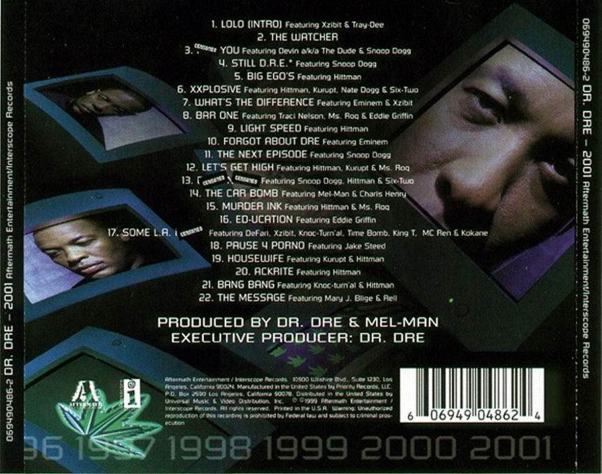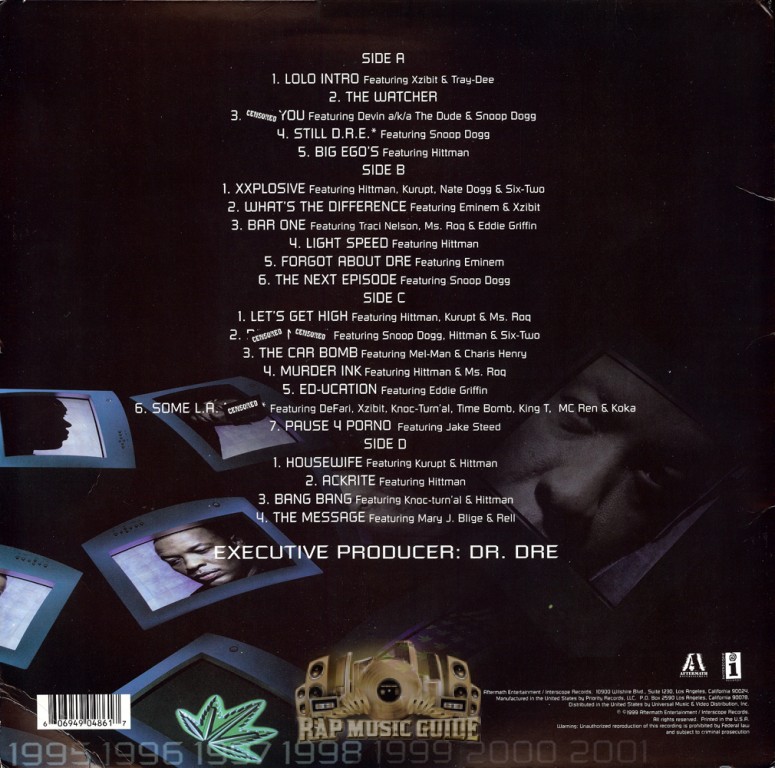

The album retains a largely Spartan aesthetic, but it still feels “big.” It’s also immaculately mixed and sounds great through car speakers and headphones. There is little to no samples on the album, with most beats created or recreated through live instrumentation. By contrast, 2001 is much more polished and “clean” sounding. By many accounts, The Chronic was a product of loose weed and alcohol-fueled studio sessions. It hit the shelves months after Aftermath’s first major success, Eminem’s debut major-label release The Slim Shady Album (1999).Ģ001 sports a much more polished sound than The Chronic. The album’s title was later changed again from Chronic 2001 to just 2001 due to complicated legal issues. However, Suge Knight beat Dre to the market with the release of his own Chronic 2000, a compilation made up of the remaining Death Row artists (including a Snoop soundalike named Topp Dogg) and unreleased material from 2Pac and Tha Dogg Pound. So much so that the album was originally to be titled Chronic 2000. The album was conceived to bring to mind thoughts of The Chronic. So Dre set out to prove he was still unfadeable with 2001. Though Death Row Records was stumbling as well (due to the death of 2Pac and another wide exodus of talent), there were rumblings about how a super-producer who could do no wrong could possibly whiff twice in a row.

Dre had only produced parts of both albums, but his name was front and center when they sputtered, leading people to question whether he’d lost his touch. Given their hype and the talent involved, both releases grossly underperformed. Dre Presents… The Aftermath nor The Firm particularly interesting works of music, they also sold poorly. It’s almost impressive that an album featuring some of the most impactful rappers of the day made little to no ripple in hip-hop’s collective consciousness. The label’s next release, a self-titled album by the supergroup The Firm (made up of Nas, AZ, Foxy Brown and others), was also forgettable. The most memorable thing associated with that album is an extended choreographed dance sequence in the video for “Been There, Done That,” where a tux-wearing Dre breaks into a very self-serious tango. Dre Presents… The Aftermath compilation, a collection of music by new and established talent that Dre released in 1996 and hoped to build a label around. You’ll be forgiven if you’ve forgotten about the existence of the Dr. The underlying theme comes from Aftermath’s growing pains and disappointing initial releases. And to think, in the years before 2001 dropped, people had wondered if the good doctor’s time had come to pass.Ģ001 is a reactive album. He created Aftermath Recordings, distributed through Interscope Records, the label of friend and frequent business partner Jimmy Iovine. He helped build Death Row Records, jump-started the career of Snoop Doggy Dogg, and then left the label that he’d created due to differences and personality clashes with the notorious Marion “Suge” Knight. In terms of sales, accolades, and recognition, Dre was, nearly seven years after releasing The Chronic, on top of the world once again. Which is all to say that 2001 was a massive hit in every possible sense. A year later, he won the Best Rap Performance By a Duo or Group for “Forgot About Dre,” featuring Eminem. In 2001, it was nominated for a GRAMMY for Best Rap Album and its first single “Still D.R.E.” earned a nomination for Best Rap Performance By a Duo or Group. Released 20 years ago, it’s just outside of the ten most commercially successful hip-hop albums of all time, moving 7.6 million units to date by comparison, The Chronic hovers around the top 30 after selling 4.6 million copies. Dre” Young’s career-defining project, but 2001 is his best-selling album. The Chronic (1992) may be considered Andre “Dr. Dre’s second studio album 2001 (sometimes referred to as The Chronic 2001), originally released November 16, 1999.


 0 kommentar(er)
0 kommentar(er)
